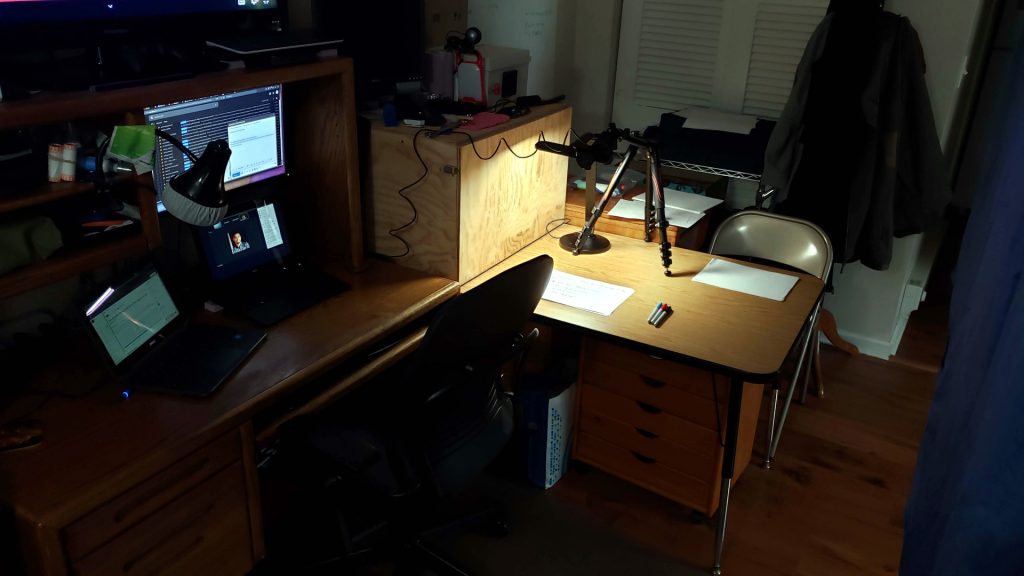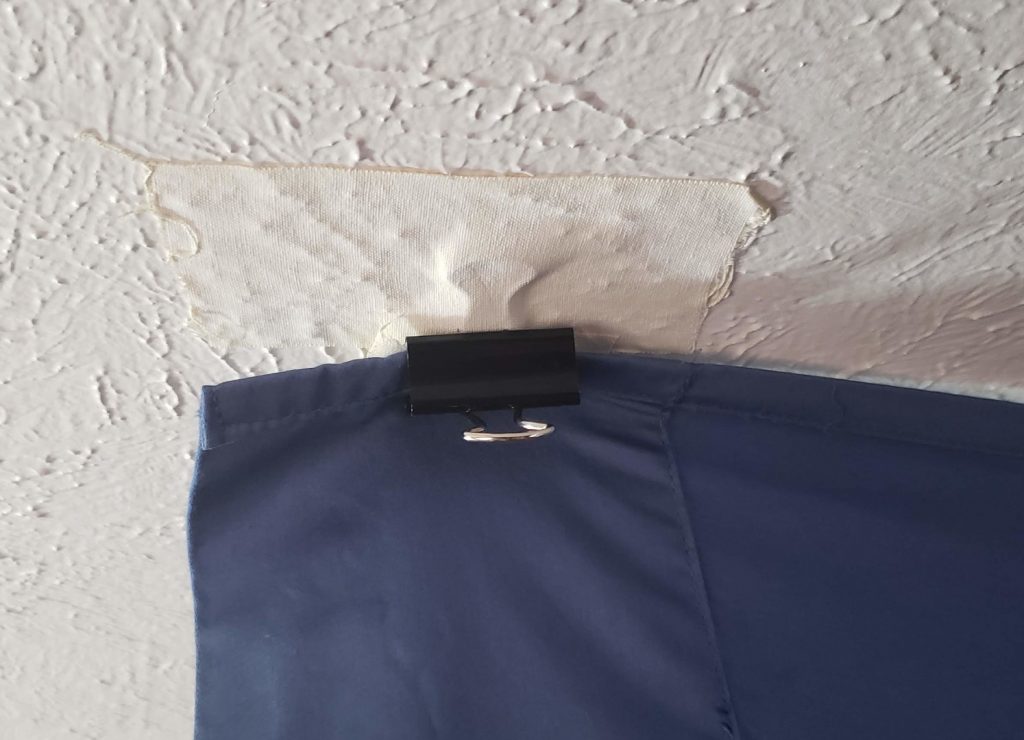
During the first week and change of our vast national COVID-19 induced remote teaching experiment I made some notes on practices and improvised some equipment that has proved useful, and seems worth sharing with others.
This two week period I’ve primarily been running lab sessions to help my herd of mostly-Sophomores do and get sign off for a digital design lab exercise using Verilog to implement state machines, adapted slightly from our usual lab at this time in the semester.
EDAPlayground: Surprisingly Acceptable
We usually use Vivado and Basys3 Artix7 FPGA Development boards to do our Verilog labs, which is lovely because students get real tools and to see their designs in hardware.
In light of the pandemic, we’re working in simulation-only to avoid the need for $150 development boards, and even rejected continuing to use Vivado as a first-choice environment because it is a 27GB install, demanding, and a little fiddly.
Instead we’re using EDAPlayground. We already use it for some homework assignments in the attached lecture course (that a shocking fraction of the mostly-CS-major non-lab students just give up on no matter how much we coach…), and it is proving a surprisingly acceptable alternative for doing the exercise in simulation.
EDAPlayground’s Verilog tools are a front-end to (extremely out-of-date) instances of free and commercial simulation and synthesis tools (we’re using Icarus), fronted by an online editor and their own lovely browser-based EPWave open-source online waveform viewing tool. With slightly more advanced students I’d be more tempted to have them install either Vivado or Icarus + GTKWave themselves, but EDAPlayground is great for cutting through the overhead and getting them back to concentrating on their design and code – a few students have even manged on iPads and such.
The technical limitations we’re running into are just Icarus’ slightly cryptic error messages, and a little funk with EPWave’s controls rendering partially offscreen in a non-scrollable box on <1000-line resolution screens.
The only thing I really miss (other than getting to see it in hardware) are the excellent schematic tools from Vivado – EDAPlayground’s Yosis/graphviz integration isn’t (yet) even close to a replacement.
Zoom: Decreasingly Acceptable
The meeting times have been me opening a room on Zoom and inviting the whole class, and it has been just barely acceptable but not compelling. Their history of privacy issues, terrible security practices, and outright lies are now so bad even the valley bro rags are turning on them. For my part, I’ve had minor annoyances with their contacts and scheduling mechanisms, and flakyness in the annotation/whiteboard features. I’ve had major annoyances with managing transitions between individual attention and talking to the whole room (“breakout rooms” are super clumsy), and especially with letting my assistants do the same as co-hosts – the lack of continuity between a main room and breakouts makes it rough for our purposes.
That Zoom is staying up under the load and basically working for chat and screen-share is commendable, and for a lot of purposes their UX is superb, but I’m not loving it for this, and not loving having it on my machine.
I was eying spinning our own BigBlueButton or Jitsi instance, but staying on university sponsored/approved tech seems like the safer choice (for FERPA reasons) as long as their suggestions are working.
One of the classes I help with is trying Microsoft Teams this week and it seems to offer a vastly superior workflow – I may be moving the one I’m calling the shots on as well.
Two Monitors (preferably stacked)
One thing I’ve learned from my and other’s shared experience is managing tele-class situations is much much improved with two monitors. I already had a VESA-arm mounted display on my desk’s hutch, and I often vertically extend to a laptop below, which it turns out is ideal. Being able to keep Zoom on my laptop’s screen, the face-camera in the middle, and other windows above is hugely helpful for managing the class on the bottom screen and keeping my materials and things I might want to share on the top screen.
Backdrop

My apartment has back-lighting windows at every angle to my desk, and a bookcase and Bosch poster are not exactly a neutral, non-distracting background, so I needed a backdrop.
The commercial solution is a bulky pop-up rack or chair-attached hoop-thing, and a sheet of tensioned chroma-key green fabric.
My solution is three medium binder clips gaffers taped to the ceiling behind my desk, and a spare flat sheet. Two strips of gaffers tape to spread out the load, one under the wire leg, and one inside the jaw holding the top flat to the ceiling.

I like this solution quite a bit for something as cobbled as it is. It’s super non-invasive, comes up and down easily, packs up small, and it works well. Also, having a very large, very apparent change in the room for “work time” is nice psychologically.
The major weaknesses are that I do have to periodically re-press the tape to avoid droop, and the sheet doesn’t quite hang flat; it tends to ripple on the bottom and give just a hint of that terrorist-beheading-video look.
Upgrades:
- Pick up a piece of flat-hanging, opaque, chroma-key green fabric to replace the sheet.
- More securely install some clips or rod supports in the ceiling behind my desk, being able to easily put it in “film mode” is handy.
- Some little weights would really help with flatness, as would a steamer or iron without a position cutoff (mine won’t steam unless it’s flat).
Overhead/Document Camera

I do a lot of drawing to explain things to students, and knew I had to be able to keep that up. Rather than trying to use one of my touchscreen devices and/or having even more fights with Zoom’s less-than-dependable annotation/ whiteboard features than I already am, I rigged myself a document camera by clamping a spare webcam (a terrible old PS3 Eye leftover from some project or another) in a cell-phone holder on the end of my boom-able tripod, and standing it around my nice diffused color-temperature-controlled desk lamp (a highly recommended impulse buy long past, a TaoTronics TT-DL27 – they make several similar models and they’re all amazing).
It has been supremely useful both for drawing, for being able to flip back to previous drawings (I considered and rejected a whiteboard because of that feature), to be able to easily put up a splash-screen during office-hours type environments, and to be able to demonstrate physical things when required.
I don’t have as much resolution as I’d like (the PS3 eye taps out at 640×480@60FPS), I’m coping by drawing with markers to force myself to draw large, it works pretty nicely. I’m also pretty limited on camera weight unless I upgrade the tripod, my little Vanguard Veo has very limited capacity when not at one 180° or the other.
This rig has been so useful that I want an improved version when things start to calm down, in part because it’s made me think about making documentation and tutorial material going forward, even working from my long-held, experience-driven stance that students usually don’t watch video content, and don’t absorb much from it even if they do.
Upgrades:
- I need more resolution. That could be a higher-end webcam, one of those little industrial UVC camera modules, or a mirrorless body on an HDMI-UVC capture device (I’ve already ordered both a 2MP industrial module with a 2.8-12mm zoom lens and a HDMI-UVC capture device, they’ll be useful for something).
- There are some nice tripods that will take substantial weight in boom mode, and some nice table-clamp boom arms to consider.
Mark your FOV
I’ve been harping for years at people using classroom document cameras and such that, especially if you’re going to do talking-hands, you really, really need to mark your camera’s field of view so you don’t wander out. The little green sticky-dots just outside the corners of my overhead camera’s FOV on the table next to my desk make it natural to frame, and the backdrop keeps me cognizant of my face-cam’s FOV.
Mixed Mode ONLY
In the “synchronous vs. asynchronous online class” discussion I’ve seen pop up various places, the only acceptable answer is “both, selectively.” Doing everything synchronous is a huge imposition and a pain in the ass for all involved. Not having some synchronous time makes the actual interactive better-than-googling-the-topic teaching parts very awkward. So, break. your. shit. up.
Provide the content-delivery parts as written materials and short, focused videos. Let students consume on their own schedule and reference as needed, with some quiz shaped deadline nudges to keep them vaguely on track. Sprinkle on some access-tracking and regular assignments so you can gauge how engaged they are. Provide the help and clarification parts as interactive online time in the richest medium available to you, and use email/forum/Piazza/etc. asynchronous Q&A tools to fill in the gaps.
LockDownBrowser is Snake Oil
I’ve watched several people try to run minimally-redesigned exams with LockDownBrowser, and it’s an obvious waste of time. A few minutes of tampering I found at least two ways to defeat it, one of which didn’t require any technical sophistication. Do your best to design assignments resistant to cheating with variant questions, avoid testing recall tasks … things that are mostly good advice anyway… and accept that a certain amount of cheating will happen.
Closing
I’m actually having quite a bit of fun with the excuse to burn hours playing with instructional technology and video production and such. I’d love to hear what is and isn’t working for others.
Possibly more to follow as I refine.

